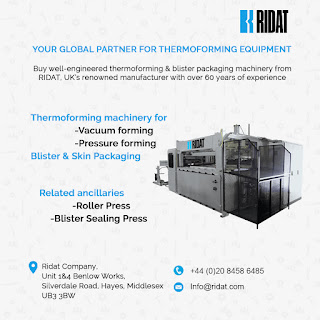All You Need to Know About Vacuum Forming Equipment
The need for more cost effective and logistics-friendly packing is continuing to drive innovation in packaging… and there are many modern packing options available on the market.
From medicines and food products to hardware for daily use, without new-age packaging techniques, everything would be different.
And the latest innovations in vacuum forming equipment have changed international packaging trends for good.
But what is vacuum forming equipment? Why do you need it? And what makes it so sought after in the packaging industry?
Ridat, your global partner for thermoforming machinery, brings you all that you need to know…
What is Vacuum Forming?
Vacuum forming is undertaken using custom equipment, which is used to heat plastic sheets and then suck them into the desired shape through the use of a mould. Vacuum forming is the simplest form of thermoforming, using just a single mould and vacuum pressure to create the shape required.
During the process, a plastic sheet is placed on a framework and then made pliable through heat. Once the plastic sheet is hot enough, vacuum suction is used to pull the sheet over the mould to give it the desired shape. After vacuuming, the shaped sheet is left to cool down and then removed from the framework for the final finishing.
Why Do You Need Vacuum Forming Equipment?
There are many benefits of vacuum forming equipment, which is why most packaging product manufacturers look to specialist thermoforming machine manufacturers such as Ridat to supply them with customized vacuum forming machines.
1. Affordable: Of all the plastic moulding techniques available, vacuum forming is not only the simplest method, but it is also a lot cheaper than alternative techniques.
2. Production Time: Vacuum forming is also significantly faster when compared to other methods. Tooling for vacuum forming equipment can be made faster, which allows business owners to create and implement designs more rapidly. This can cut down the time it takes from an idea to go from the drawing board to its intended market.
3. Flexible: The low cost and production time associated with vacuum forming can give manufacturers greater flexibility at the initial product design stages. Designers can take more time when developing and testing prototypes, and they can make changes faster as turnaround times are shorter when compared to other moulding techniques.
4. Advertising: Unlike other methods, vacuum forming is more precise and offers a better fit to shap; this can make a product look much more appealing. The appearance of the product can be a major factor in converting a potential customer.
Where can you buy Vacuum Forming Equipment?
Ridat offers a wide range of custom vacuum forming machine manufacturing services.
We have more than 60 years of specialist manufacturing experience and our company has an international reputation for producing innovative vacuum forming machinery which is developed in line with industry needs.
Our vacuum forming range is competitively priced and offers long-term value for money.
Our vacuum forming range includes Midmatic Vacuum Forming Machines which are suitable for small to medium volume production runs, Industrial Vacuum Former (AVF) Machines for moulding thick sheets of thermoformable materials, Semi-Automatic Vacuum Forming (SA) Machines, Semi Manual (SM series) Vacuum Forming Machines, Manual (M series) Vacuum Forming Machines for small production runs & prototyping and MediVac Vacuum Forming Machines, which have been designed specifically for moulds for radiotherapy shells.
These are matched by our AFCS series of 3 & 4 stage thermoformers and ATF series of Large Format inline thermoformer for volume production.
Ridat’s machines are used in multiple sectors and we have successfully sold our products to more than 65 countries worldwide.
To discuss your requirements, get in touch with us now. To find out more about our products, visit RIDAT Company.


